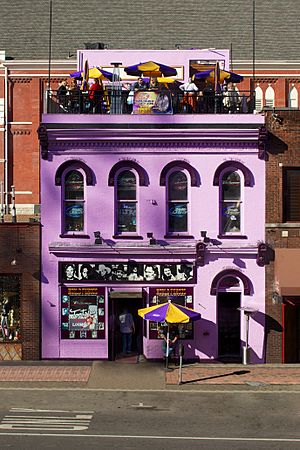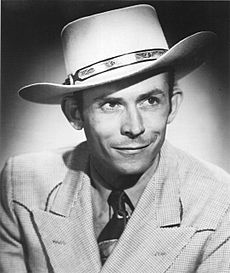Honky-tonk facts for kids

A honky-tonk is a type of bar that offers live country music for people to enjoy. It can also refer to the style of music played in these places. Sometimes, it even describes the kind of piano (called a tack piano) used for this music.
These bars are very common in the Southern and Southwestern parts of the United States. Many famous country music stars started their careers playing in honky-tonks. Artists like Jimmie Rodgers, Loretta Lynn, Patsy Cline, Ernest Tubb, Johnny Horton, and Merle Haggard all began this way.
The exact beginning of the word "honky-tonk" is not fully known. It might have first referred to variety shows in the old West, especially in places like Oklahoma, the Indian Territories, and Texas. It could also have described the theaters where these shows took place.
The first type of music known as honky-tonk was a style of piano playing. It was similar to ragtime but focused more on rhythm than on melody or harmony. This style developed because pianos in these places were often old and not well cared for. They might have been out of tune or had broken keys. This early honky-tonk piano music was a big influence on the boogie-woogie piano style.
Before World War II, the music industry started calling the hillbilly music played from Texas to the West Coast "honky-tonk" music. In the 1950s, honky-tonk music became very popular. This time is often called its "golden age." Famous artists from this era include Winifred Atwell, Webb Pierce, Hank Locklin, Lefty Frizzell, Ray Price, Faron Young, George Jones, and Hank Williams.
What is Honky-Tonk Music?
The honky-tonk sound has a strong rhythm section. This means the drums and bass play a steady, two-beat rhythm with a clear backbeat. The main instruments you'll hear are the steel guitar and the fiddle.
The earliest honky-tonk music was a style of piano playing. It was like ragtime but put more focus on the beat and rhythm. This style came about because pianos in these venues were often old and not in perfect tune. Some keys might not have worked well.
Honky-tonk music had a big impact on the boogie-woogie piano style. For example, Jelly Roll Morton recorded a song called "Honky Tonk Music" in 1938. Also, Meade Lux Lewis had a hit song called "Honky Tonk Train Blues." Lewis recorded this song many times from the 1920s to the 1950s. Many other musicians, including Oscar Peterson, also played this song.
The Bill Doggett Combo had an early rock and roll hit with their song "Honky Tonk." This song was a twelve-bar blues instrumental. It featured a smooth saxophone line and a strong, slow beat. New Orleans musician Fats Domino was another honky-tonk piano player. His songs "Blueberry Hill" and "Walkin' to New Orleans" were popular hits.
How Honky-Tonk Music Evolved
Before World War II, the music industry started calling the country music played in Texas and Oklahoma "hillbilly music." Later, the term "honky-tonk" became the main name for a certain sound in country music. This sound developed in Nashville as Western swing became popular there.
Originally, honky-tonk music featured the guitar, fiddle, string bass, and steel guitar. The steel guitar came from Hawaiian folk music. The singers often had a rough, nasal voice, like Floyd Tillman and Hank Williams. Over time, the vocals became clearer and sharper, like those of George Jones and Faron Young.
The songs often talked about the lives of working-class people. They frequently had sad themes about lost love, feeling lonely, and self-pity.
In 1941, Ernest Tubb released "Walking the Floor Over You." This song helped make the honky-tonk style famous. It also made Tubb one of its most important musicians. Ernest Tubb, from Crisp, Texas, loved Jimmie Rodgers' music. He combined Western swing, which had been using electric guitars for years, with other "country" sounds.
Ernest Tubb brought this sound to Nashville. He was the first musician to play an electric guitar on the Grand Ole Opry stage. In the 1950s, honky-tonk music reached its "golden age." Artists like Webb Pierce, Hank Locklin, Lefty Frizzell, Faron Young, George Jones, and Hank Williams were very popular.
In the mid-to-late 1950s, other music styles became popular. Rockabilly mixed honky-tonk country with rhythm and blues. The smooth country music of the Nashville sound also emerged. These new styles ended honky-tonk's first period of being the most popular country music.
The famous band The Rolling Stones had a number-one hit song called "Honky Tonk Women" in 1969. This song was inspired by the sound of 1940s honky-tonk artists like Hank Williams. In the 1970s, a style called outlaw country brought back a rougher honky-tonk sound. Artists like Gary Stewart, Waylon Jennings, Willie Nelson, David Allan Coe, and Billy Joe Shaver were part of this movement.
See also
 In Spanish: Honky tonk para niños
In Spanish: Honky tonk para niños


